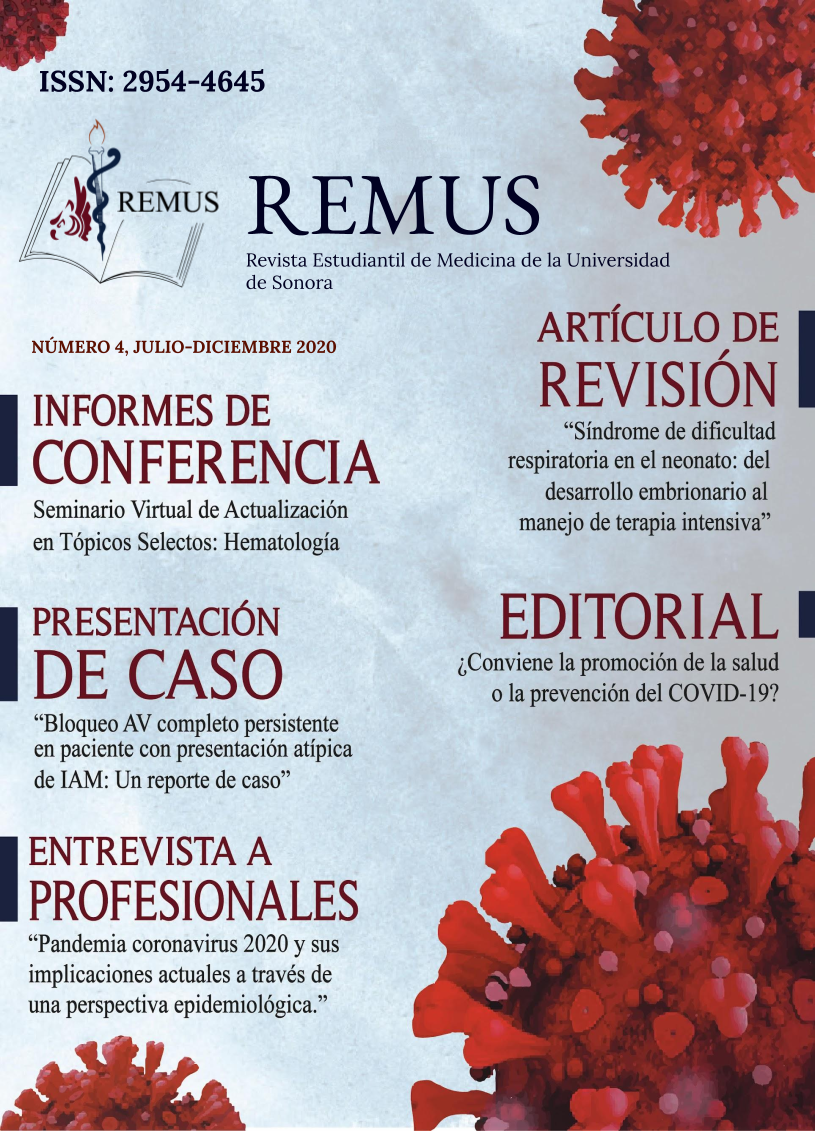Persistent complete AV block in a patient with an atypical presentation of AMI: A case report
Persistent complete AV block in a patient with an atypical presentation of AMI: A case report
DOI:
https://doi.org/10.59420/remus.4.2020.36Keywords:
Atypical AMI, persistent complete heart blockAbstract
When a tissue suffers ischemia, time is a crucial therapeutic and prognostic factor. Patients that do not express chest pain while they experience an acute myocardial infarction (AMI) are considered as an atypical presentation, and are more likely not to arrive in window period for reperfusion therapy. This situation triggers a series of events that influence negatively in the prognosis compared to patients with typical presentation. Complete atrioventricular (AV) block is an electrical complication in ST elevation AMI, associated with a less favorable evolution, and even worse when reperfusion therapy is not implemented, since it is associated with a longer duration of the arrythmia, longer hospital stay and higher mortality at 30 and 365 days. We present the case of a 50 year old male who suffered an inferior AMI with anteroseptal extension, complicated with a complete atrioventricular (AV) block, who denied any kind of thoracic discomfort, and decided to go to the hospital 72 hours after the symptoms started. Therefore, it was decided not to reperfuse. This complication is usually transient, thus persistent presentations are rare and are associated with severe AV node necrosis. Our patient is one of the few cases with AMI in which a permanent pacemaker is indicated. The atypical presentation factor had an impact on the evolution and prognosis of the patient. Thereby, the main goal of this case report is to make first contact physicians aware of how important is to identify and manage an atypical AMI as soon as possible.
Downloads
References
Brieger, D., Eagle, K. A., Goodman, S. G., Steg, P. G., Budaj, A., White, K., & Montalescot, G. (2004). Acute Coronary Syndromes Without Chest Pain, An Under-diagnosed and Undertreated High-Risk Group. Chest, 126(2), 461–469.
Canto J. G., Shlipak M. G., Rogers W. J., et al. Preva-lence, Clinical Characteristics, and Mortality Among Patients With Myocardial Infarction Presenting Without Chest Pain.JAMA. 2000;283(24):3223–3229.
Dorsch M. F., Lawrance R. A., Sapsford R. J., et al. Poor prognosis of patients presenting with symptomatic myocardial infarction but without chest pain. Heart 2001;86:494-498.
Vogler J., Breithardt G., Eckardt L. Bradyarrhythmias and Conduction Blocks. Revista Española de Cardiolo-gía (English Edition). 2012;65(7):656-667.
Aplin, M., Engstrøm, T., Vejlstrup, N. G., Clemmensen, P., Torp-Pedersen, C., & Køber, L. (2003). Prognostic importance of complete atrioventricular block complica-ting acute myocardial infarction. The American Journal of Cardiology, 92(7), 853–856. doi:10.1016/s0002
Harikrishnan P., Gupta T., Palaniswamy C., Kolte D., Khera S., Mujib M. et al. Complete Heart Block Com-plicating ST-Segment Elevation Myocardial Infarction. JACC: Clinical Electrophysiology. 2015;1(6):529-538.
Chiladakis, J. P., Nikolaos A.. (2003). The Bezold- Jarisch reflex in acute inferior myocardial infarction: Clinical and sympathovagal spectral correlates. Clinical cardiology. 26. 323-8. 10.1002/clc.4950260706.
Berger, P. B., Ruocco, N. A., Ryan, T. J., Frederick, M. M., Jacobs, A. K., & Faxon, D. P. (1992). Incidence and prognostic implications of heart block complicating inferior myocardial infarction treated with thrombolytic therapy: Results from TIMI II. Journal of the American College of Cardiology, 20(3), 533–540.
García C., Curós A., Serra J., Tizón H., Carol A., Valle V. Duración del bloqueo auriculoventricular completo en el infarto inferior tratado con fibrinólisis. Revista Española de Cardiología. 2005;58(1):20-26.
Auffret, V., Loirat, A., Leurent, G., Martins, R. P., Fi-lippi, E., Coudert, I., … Le Breton, H. (2015). High-degree atrioventricular block complicating ST segment elevation myocardial infarction in the contemporary era. Heart, 102(1), 40–49.
Simons, G. R., Sgarbossa, E., Wagner, G., Califf, R. M., Topol, E. J., & Natale, A. (1998). Atrioventricular and Intraventricular Conduction Disorders in Acute Myocar-dial Infarction: A Reappraisal in the Thrombolytic Era. Pacing and Clinical Electrophysiology, 21(12), 2651– 2663. doi:10.1111/j.1540-8159.1998.tb00042.x
Vardas P, Auricchio A, Blanc J, Daubert J, Drexler H, Ector H et al. Guidelines for cardiac pacing and cardiac resynchronization therapy: The Task Force for Cardiac Pacing and Cardiac Resynchronization Therapy of the European Society of Cardiology. Developed in Collabo-ration with the European Heart Rhythm Association. Europace. 2007;9(10):959-998.
Downloads
Published
How to Cite
Issue
Section
License
Copyright (c) 2020 REMUS - Revista Estudiantil de Medicina de la Universidad de Sonora

This work is licensed under a Creative Commons Attribution-NonCommercial-NoDerivatives 4.0 International License.


